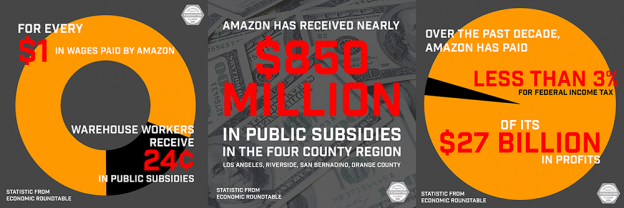For every $1 in wages paid by Amazon, warehouse workers receive 24 cents in public assistance benefits
Households in the Los Angeles metro region paid $7.2 billion for packages from Amazon last year. Less publicly visible was more than $790 million paid out in public subsidies and uncompensated public costs that supported Amazon’s profitability.
Every day, ships, trucks, trains, and airplanes bring an estimated 21,500 diesel truck loads of merchandise to 21 Amazon warehouses in the four-county region. An estimated 18,600 workers are employed at these Amazon warehouses. The impact of these logistics operations in the Los Angeles-Orange-Riverside-San Bernardino-county region are scrutinized in a new report by the Economic Roundtable, Too Big to Govern.
Amazon’s warehouses have been welcomed as a source of jobs and economic growth by poorer, job-hungry communities. Local cities and the state have provided an estimated $30 million to subside construction of Amazon’s warehouses. With no better local alternatives, workers struggle to hang on to jobs that many say are repetitive, exhausting and stressful.
Arthur Medrano, who worked as an unloader/thrower at a Rialto warehouse, said, “All they care about is how you can make them money. They increase your productivity requirements out of nowhere and expect you to reach them without an issue. It’s extreme hard work with constant job insecurity and low pay. I couldn’t afford to rent my own place when I worked there and I know others faced the same issues.”
The typical Amazon warehouse worker had total annual earnings in 2017 of $20,585. For every dollar in wages paid by Amazon, warehouse workers receive an estimated 24 cents in public assistance benefits to meet essential needs. The average annual amount of public benefits per worker is $5,245. The biggest component is publicly subsidized health insurance.
As a consequence of having low wages and insufficient incomes to afford adequate homes for their families, 57% of Amazon warehouse workers live in housing that is overcrowded and substandard. Housing records provide direct and indirect evidence of significant homelessness among warehouse workers.
“There is growing activism among low-wage workers like Amazon’s warehouse employees. There is also growing public outrage that the nation’s largest and most profitable private employers are not paying workers enough to cover their workers’ basic living expenses,” said Peter Dreier, professor of political science at Occidental College.
Public Records Act requests were sent to 39 public jurisdictions where Amazon facilities are located. Nineteen jurisdictions said they had no records related to Amazon. Thirteen had minimal permit records, and seven had completed environmental impact reports. No impacts on the environment, traffic or human well-being were identified that warranted stopping a project.
Often job creation was identified as the reason for proceeding with a project.
Environmental costs include global warming impacts from 620,000 metric tons of CO2 emissions a year from Amazon’s cargo flights into and out of local airports, and 15 billion ton-miles of diesel truck travel a year hauling cargo from sea ports to warehouses and releasing harmful emissions into low-income communities along freeway corridors.
Ongoing annual public costs for Amazon’s warehouse and shipping operations in the LA Metro region include:
- $45 million annually for climate change impacts from cargo aircraft flights
- $98 million annually in public assistance for warehouse workers
- $647 million annually in uncompensated public costs for noise, road wear, accidents, and harmful emissions. warehouse trucking
“Amazon is now a dominant force in shaping communities where its logistics operations are located and its workers live. More complete oversight is needed to assess the risk and impacts of Amazon’s operations and to ensure that local costs are paid,” said Daniel Flaming, Economic Round Table President.
The report makes nine recommendations for Amazon to step up to achieve equity in communities supporting Amazon’s logistics operations. Key recommendations include:
- Paying warehouse workers and delivery drivers a minimum of $20 an hour
- Providing comprehensive affordable health insurance
- Allowing work breaks that let warehouse workers drink enough water, use bathrooms and eat mid-shift
- Investing in building affordable housing for warehouse workers
- Deploying zero emission trucks and delivery vehicles to reduce Amazon’s carbon footprint
About Economic Roundtable:
The Economic Roundtable is a nonprofit urban research organization based in Los Angeles that carries out large-scale data analyses to identify actionable solutions to social, economic and environmental problems. To learn more, please visit economicrt.org.

